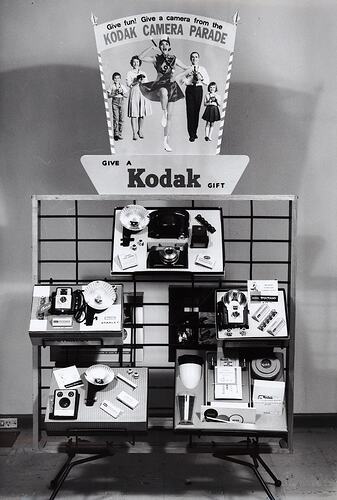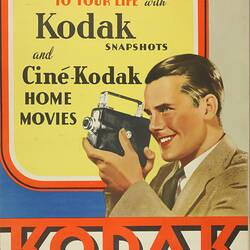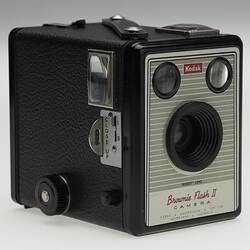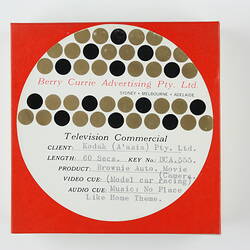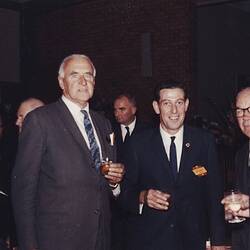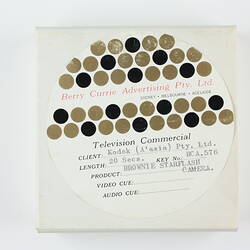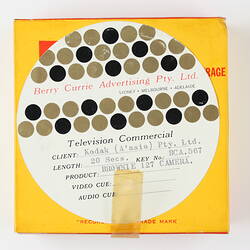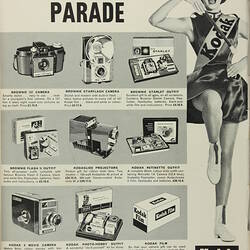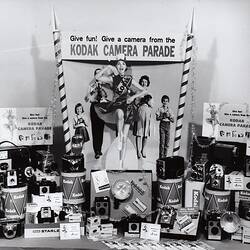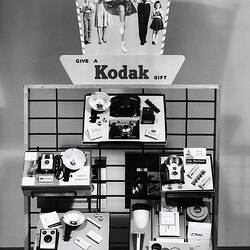'Kodak Camera Parade' was a highly visible, Christmas holiday promotional campaign run by Kodak Australasia in the early 1960s. The campaign was promoting Kodak's new, modern, and simple to use Instant cameras. It had a print, television, and point-of-sale presence to ensure maximum product exposure, and it typifies the imagery and marketing approaches of Kodak in the mid-twentieth century.
Picture it: A sprightly, athletic marching girl in uniform strides towards you. Her peaked cap sits atop her head, stitched with the letter 'K' for Kodak. She has a baton held high and a sash with 'Kodak' blazoned across it. She's fun, she's pretty, she's leading the way - and she's selling you a parade of Kodak cameras.
This marching girl actually appeared two years earlier in an American campaign of the same name. Kodak Australasia commonly borrowed from Eastman Kodak campaigns that proved successful or adaptable to Australia, as it saved on time and costs domestically. Namely, it avoided the creative fee charged by local advertising companies for new ideas. The advertising firm, in this case Berry Currie & Hawkins, worked the American idea into an Australian campaign, which was run across multiple platforms. Leading up to Christmas, consumers would have seen the marching girl on TV, in their morning paper, and in the shops. In shops there were merchandising units, including some in the shape of tents flanked by one or two cardboard marching girls. Inside the tents was a selection of cameras, film and accessories available for purchase.
Simultaneously, Kodak launched a television campaign featuring the slogan 'Give Fun, Give A Kodak' which concluded with a marching girl. The persuasive element was 'fun'. The commercials suggested, through short catchy phrases underscored by a simple jingle and idyllic images of children at play, that with a camera you could have 'Fun for years to come' and that 'Fun's twice as fun'. Kodak were marketing themselves to every member of the family and provided a product for a variety of budgets. At the end of each commercial, the same 10 second clip of the marching girl and the same repeated voice-over came in to drive home the message. 'It's just one of the many cameras to choose from in the Kodak Camera Parade' and away marched the marching girls.
Why a marching girl? John Kerr, a former Marketing Manager at Kodak Australasia, was working as a young sales rep at the time and witnessed the high sales of Brownie cameras in stores. In a recent interview with Museum Victoria, John said marching girls were the 'in' thing of the early 1960s. The advertising approach assumed that every girl wanted to be one and every boy wanted to date one.
By creating a simple and adaptable message of fun and modernity, exemplified by the Marching Girl, Kodak was able to promote basically all of the major, new release instant cameras it had on the market, and many of those came as Outfits with film, flash bulbs and other accessories. Some of the products promoted in the Kodak Camera Parade campaign were: The Brownie Flash II and Flash II Outfit, Brownie Starlet and Starlet Outfit, the Brownie 127 Camera, the Brownie Starflash and Starflash Outfit, and Kodak Film.
References
The Sydney Morning Herald, 20 Dec 1962, p 7 Url: http://news.google.com/newspapers?id=q2YUAAAAIBAJ&sjid=BgEEAAAAIBAJ&pg=5766%2C119828
The Sydney Morning Herald, 11 Dec 1962, p 11. URL:http://news.google.com/newspapers?id=cONYAAAAIBAJ&sjid=-OUDAAAAIBAJ&pg=6800%2C2540186
Kerr, J. in an interview recorded by Fiona Kinsey, 28 June 2012, Melbourne Museum, Victoria, Kodak Heritage Collection, Melbourne Museum
More Information
-
Keywords
Photography, Advertising, Retailing, Promotional Materials, Television Production
-
Authors
-
Article types
